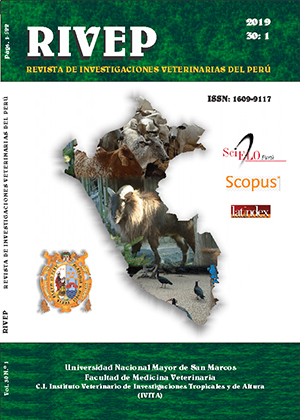Antimicrobial susceptibility of staphylococci isolated in canine pyoderma in Coro, Venezuela
DOI:
https://doi.org/10.15381/rivep.v30i1.14608Keywords:
Staphylococcus pseudintermedius; canine pyoderma; MDR; XDR; MRSA; MRSP; MSSPAbstract
This retrospective investigation was focused on the study of the etiology of pyoderma in canines from the city of Coro (Falcón state, Venezuela), between 2010 and 2014, as well as the profile of antimicrobial susceptibility of staphylococcal bacteria. The most frequently isolated microorganism was Staphylococcus (pseud)intermedius, followed by Staphylococcus aureus and other species. Additionally, several multi-resistant isolates were detected for the two species mentioned, which did not correlate with cases of recurrent pyoderma. No significant association was detected between the recurrent pyoderma and risk factors such as the racial pattern, sex, age and infecting bacterial species. In general, isolated staphylococcal species showed significant (p<0.05) susceptibility to carbapenems, aminoglycosides and fluoroquinolones, and resistance to penicillin, cyclins, inhibitors of folate synthesis and polypeptides.
Downloads
Downloads
Published
Issue
Section
License
Copyright (c) 2019 Victor Chávez Oberto, Glenda Monzant López, Lilia Lisbeth Carrero Portillo

This work is licensed under a Creative Commons Attribution-NonCommercial-ShareAlike 4.0 International License.
AUTHORS RETAIN THEIR RIGHTS:
a. Authors retain their trade mark rights and patent, and also on any process or procedure described in the article.
b. Authors retain their right to share, copy, distribute, perform and publicly communicate their article (eg, to place their article in an institutional repository or publish it in a book), with an acknowledgment of its initial publication in the Revista de Investigaciones Veterinarias del Perú (RIVEP).
c. Authors retain theirs right to make a subsequent publication of their work, to use the article or any part thereof (eg a compilation of his papers, lecture notes, thesis, or a book), always indicating the source of publication (the originator of the work, journal, volume, number and date).



